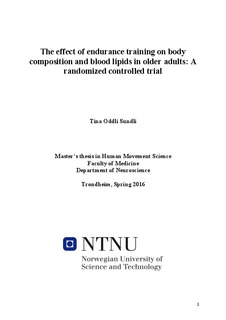| dc.description.abstract | Background: Ageing is associated with changes in body composition and blood lipids.
Reduced muscle mass and increased body fat are inevitable consequence of the ageing
process. In addition, total cholesterol is known to increase with age, and increased body fat has shown associations with abnormal lipid values. Limited information is available regarding the effects of endurance training on blood lipids in elderly, and the effect of endurance training on body composition. The present study examines the effects of three years of endurance training on body composition and blood lipids in older adults. Possible gender differences will also be investigated. Materials and methods: This was a population-based randomized controlled trial. Body composition and blood lipids were determined in 400 healthy community-dwelling men and women (204 women and 194 men with a mean age of 71.9 ± 1.36). Body composition was measured using bioelectrical impedance analysis and blood lipids were measured by taking a blood sample from an arm vein in a fasted state.Results: Three years of endurance training resulted in modest reduction in body weight, with larger reduction in the high-intensity training group compared with the moderate-intensity training group (p<0.01). Visceral fat increased over the three year period in the control and moderate-intensity training groups, but not in the high-intensity training group (p<0.01). Endurance training did not affect blood lipids (p>0.05). Gender differences were prominent in body composition and blood lipid measures at baseline and in interaction with group and time (p<0.05). There were gender differences in response to endurance training in terms of waist, BMI, visceral fat and LDL-cholesterol (p<0.05). Women showed a larger reduction in waist and BMI in the high-intensity training group than men (p<0.015), and men showed a larger reduction in LDL-cholesterol and visceral fat the control and moderate-intensity training groups than women (p<0.05). Men and women also changed differently in muscle mass and
triglycerides over time (p<0.05), with men decreasing more than women. Conclusion: These results demonstrate that three years of endurance training has modest effect on body composition and no effect on blood lipids. Gender differences in body composition and blood lipids were prominent at baseline. In addition, few gender differences were seen in response to training. Women reduced waist and BMI more than men in the high-intensity training group, whereas men reduced LDL-cholesterol and visceral fat more than women in the control and moderate-intensity training groups. Men and women also changed differently in muscle mass and triglycerides over time, with men decreasing more than women. | nb_NO |
